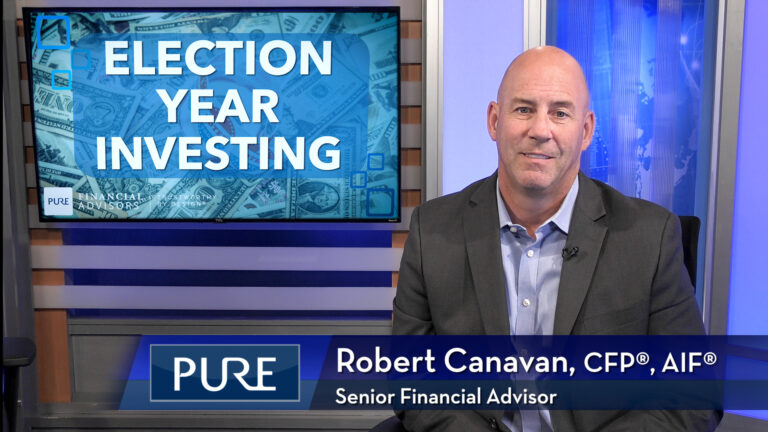Do you understand the differences between a Traditional IRA and a Roth IRA? Pure’s Financial Planner, Nick Rose, CFP®, breaks down the tax benefits, contribution limits, and phase out ranges for both IRAs to help you determine what option might be best for your financial situation.
FREE GUIDE | The Ultimate IRA Guide
Transcript
If you’re wondering which IRA is right for you, basically, it comes down to: when do you want to pay the tax?
In a Roth IRA, you will pay taxes on your initial contribution but it will grow tax-free and your withdrawals in retirement will not be taxed. In a Traditional IRA, you can contribute pre-tax dollars, take advantage of a tax-break that year, and enjoy tax-deferred growth, but you will pay taxes when you withdraw during retirement.
2023 IRA Changes
The contribution limit for employees who participate in 401(k), 403(b), most 457 plans, and the federal government’s Thrift Savings Plan is increased to $22,500, up from $20,500. The limit on annual contributions to an IRA increased to $6,500, up from $6,000. The IRA catch-up contribution limit for individuals aged 50 and over is not subject to an annual cost-of-living adjustment and remains at $1,000. The catch-up contribution limit for employees aged 50 and over is increased to $7,500, up from $6,500. Therefore, participants in 401(k), 403(b), most 457 plans, and the federal government’s Thrift Savings Plan who are 50 and older can contribute up to $30,000, starting in 2023. The amount individuals can contribute to their SIMPLE retirement accounts is increased to $15,500, up from $14,000. The catch-up contribution limit for employees aged 50 and over who participate in SIMPLE plans is increased to $3,500, up from $3,000.
Taxpayers can deduct contributions to a traditional IRA if they meet certain conditions. If during the year either the taxpayer or the taxpayer’s spouse was covered by a retirement plan at work, the deduction may be reduced, or phased out, until it is eliminated.
Phase-Out Ranges for 2023
Here are the phase-out ranges for 2023. For single taxpayers covered by a workplace retirement plan, the phase-out range is increased to between $73,000 and $83,000. For married couples filing jointly, if the spouse making the IRA contribution is covered by a workplace retirement plan, the phase-out range is increased to between $116,000 and $136,000. For an IRA contributor who is not covered by a workplace retirement plan and is married to someone who is covered, the phase-out range is increased to between $218,000 and $228,000. For a married individual filing a separate return who is covered by a workplace retirement plan, the phase-out range is not subject to an annual cost-of-living adjustment and remains between $0 and $10,000.
The phase-out range for taxpayers making contribution to a Roth IRA increased to between $138,000 and $153,000 for singles and heads of household. For married couples filing jointly, the income phase-out range is increased to between $218,000 and $228,000. The phase-out range for a married individual filing a separate return who makes contributions to a Roth IRA is not subject to an annual cost-of-living adjustment and remains between $0 and $10,000.
Saver’s Credit
The income limit for the Saver’s Credit (also known as the Retirement Savings Contributions Credit) for low- and moderate-income workers is $73,000 for married couples filing jointly, $54,750 for heads of household, and $36,500 for singles and married individuals filing separately.
So, which is right for you? A traditional IRA or a Roth IRA. You don’t necessarily have to make an all-or-nothing choice. You may be able to have both, and decide year-by-year where you want to make your contributions. Find out today, contact Pure Financial Advisors for a free financial assessment.
Subscribe to our YouTube channel.
IMPORTANT DISCLOSURES:
• Investment Advisory and Financial Planning Services are offered through Pure Financial Advisors, LLC, a Registered Investment Advisor.
• Pure Financial Advisors LLC does not offer tax or legal advice. Consult with your tax advisor or attorney regarding specific situations.
• Opinions expressed are subject to change without notice and are not intended as investment advice or to predict future performance.
• Investing involves risk including the potential loss of principal. No investment strategy can guarantee a profit or protect against loss in periods of declining values.
• All information is believed to be from reliable sources; however, we make no representation as to its completeness or accuracy.
• Intended for educational purposes only and are not intended as individualized advice or a guarantee that you will achieve a desired result. Before implementing any strategies discussed you should consult your tax and financial advisors.
CFP® – The CERTIFIED FINANCIAL PLANNER™ certification is by the Certified Financial Planner Board of Standards, Inc. To attain the right to use the CFP® designation, an individual must satisfactorily fulfill education, experience and ethics requirements as well as pass a comprehensive exam. Thirty hours of continuing education is required every two years to maintain the designation.














